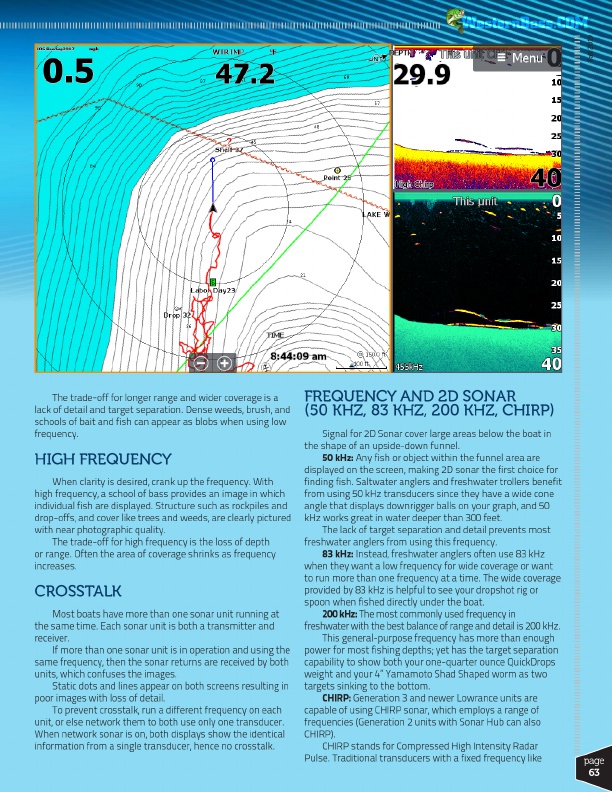
®
Fall 2019
The trade-off for longer range and wider coverage is a lack of detail and target separation. Dense weeds, brush, and schools of bait and fish can appear as blobs when using low frequency.
HIGH FREQUENCY
When clarity is desired, crank up the frequency. With high frequency, a school of bass provides an image in which individual fish are displayed. Structure such as rockpiles and drop-offs, and cover like trees and weeds, are clearly pictured with near photographic quality.
The trade-off for high frequency is the loss of depth or range. Often the area of coverage shrinks as frequency increases.
CROSSTALK
Most boats have more than one sonar unit running at the same time. Each sonar unit is both a transmitter and receiver.
If more than one sonar unit is in operation and using the same frequency, then the sonar returns are received by both units, which confuses the images.
Static dots and lines appear on both screens resulting in poor images with loss of detail.
To prevent crosstalk, run a different frequency on each unit, or else network them to both use only one transducer. When network sonar is on, both displays show the identical information from a single transducer, hence no crosstalk.
FREQUENCY AND 2D SONAR (50 KHZ, 83 KHZ, 200 KHZ, CHIRP)
Signal for 2D Sonar cover large areas below the boat in the shape of an upside-down funnel.
50 kHz: Any fish or object within the funnel area are displayed on the screen, making 2D sonar the first choice for finding fish. Saltwater anglers and freshwater trollers benefit from using 50 kHz transducers since they have a wide cone angle that displays downrigger balls on your graph, and 50 kHz works great in water deeper than 300 feet.
The lack of target separation and detail prevents most freshwater anglers from using this frequency.
83 kHz: Instead, freshwater anglers often use 83 kHz when they want a low frequency for wide coverage or want to run more than one frequency at a time. The wide coverage provided by 83 kHz is helpful to see your dropshot rig or spoon when fished directly under the boat.
200 kHz: The most commonly used frequency in freshwater with the best balance of range and detail is 200 kHz.
This general-purpose frequency has more than enough power for most fishing depths; yet has the target separation capability to show both your one-quarter ounce QuickDrops weight and your 4” Yamamoto Shad Shaped worm as two targets sinking to the bottom.
CHIRP: Generation 3 and newer Lowrance units are capable of using CHIRP sonar, which employs a range of frequencies (Generation 2 units with Sonar Hub can also CHIRP).
CHIRP stands for Compressed High Intensity Radar Pulse. Traditional transducers with a fixed frequency like
page
63